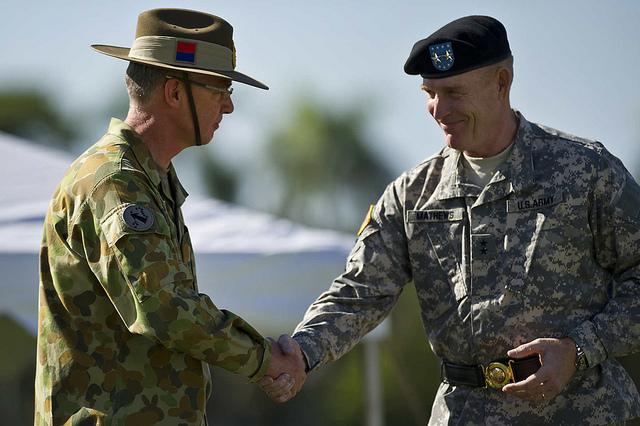What’s at the centre (center?) of the Anglosphere?
Posted By Andrew Smith on July 18, 2013 @ 12:00
The recent exchanges between Peter Jennings [2], Hugh White [3] and Nic Stuart [4] over the existence and value of the ‘Anglosphere’ have been both entertaining and timely. I’ve found things to agree with in all their contributions but tend to come down on Peter’s side. The term characterises as well as anything the origins of the current international order—the maintenance of which is very much in Australia’s interest.
I also agree with both Peter and Hugh that, from a Defence perspective, membership of the Anglosphere’s inner sanctum, the ‘Five Eyes’ club has been hugely advantageous to Australia. But Hugh’s characterisation of the Five Eyes as simply an intelligence-sharing relationship doesn’t do it justice—it’s much more significant than that—not only for its members, but for the ‘Anglosphere Plus’ (NATO and Japan) which Peter alludes to. It also demonstrates one of the fundamentals of the Anglosphere—the indispensability of US leadership—and in doing so creates a challenge to its own exclusivity, as well as opportunities and responsibilities for Australia.
While I agree with the essential likemindedness that Peter claims for the Five Eyes, the group is much less a quintipartite band of equals than it is four bilateral relationships with the US flying in close formation. Without the US, the other four would likely be crosseyed. Yet they get more from America strategically than America does from them. In Australia’s case, this includes not only access to technology and intelligence but also, over the last decade, the chance to fill senior and prominent roles in US-led coalitions, often disproportionate to our contributions of other, costlier capabilities. Achieving priceless experience for ADF personnel as well as profile with our principal ally is a great deal for Australia.
The other junior partners do the same, but this can be divisive of the wider coalition, especially ‘old NATO’ countries who are jealous of the Five Eyes’ exclusivity. The danger for the Five Eyes members—particularly the US—is that however comfortable they are working together, usually they won’t combine enough military wherewithal or international legitimacy to get the job done. Afghanistan’s a case in point, which the US had to reinvent as a NATO mission. Looming problems in the Gulf are another: Australia will never put a carrier group through the Straits of Hormuz. But France can (and recently has), as well as being proactive in Mali. Yet France can’t command the same relationship with the USA—something which frustrates it and, no doubt, makes it harder for Hollande to support Anglospheric goals.
This isn’t to say that Australia should relinquish its hard-earned place in the inner sanctum. Rather, it might be time to consider admitting others to that exclusive club. We should also use our position to build cohesion in that part of the Anglosphere Plus that, realistically, will never be among ‘the few’. We bring some real capacity to that role: most countries see us as a good international citizen, with much less historical or relationship baggage than many others. We can really assist the US in its leadership role, if we are a little selfless. This might require us to continue to engage, judiciously, well outside our near region, even after 2014. Given our stake in global security, albeit as a regional power, that isn’t too much to ask.
Andrew Smith is an independent researcher based in the United States. Image courtesy of Flickr user PACOM [5].
Article printed from The Strategist: https://aspistrategist.ru
URL to article: /whats-at-the-centre-center-of-the-anglosphere/
URLs in this post:
[1] Image: https://aspistrategist.ru/wp-content/uploads/2013/07/8393257052_5c63043bd0_z.jpeg
[2] Peter Jennings: https://aspistrategist.ru/alliances-three-cheers-for-the-anglosphere/
[3] Hugh White: https://aspistrategist.ru/sunset-for-the-anglosphere/
[4] Nic Stuart: https://aspistrategist.ru/where-exactly-is-the-anglosphere/
[5] PACOM: https://aspistrategist.ruFORT SHAFTER, Hawaii (Jan. 17, 2013) - Maj. Gen. Roger F. Mathews Deputy Commanding General U.S. Army, Pacific (USARPAC) welcomes Australian Defense Force Maj. Gen. Richard M. Burr, Headquarters U.S. Army Pacific Deputy Commanding General of Operations during a Deputy Commanding General flying V Ceremony at the Historic Palm Circle. The ceremony held to welcome Burr and his family as the first foreign military officer to be assigned at this level of leadership in the U.S. Army. Burr’s appointment as the USARPAC Deputy Commanding General of Operations signifies the continuing strong relationship between the U.S. and Australia and further shows the support by both countries for the National strategy of ensuring stability and security throughout the Pacific Region. (Department of Defense photo by U.S. Air Force Tech. Sgt. Michael R. Holzworth) 130117-F-MQ656-177
Click here to print.
